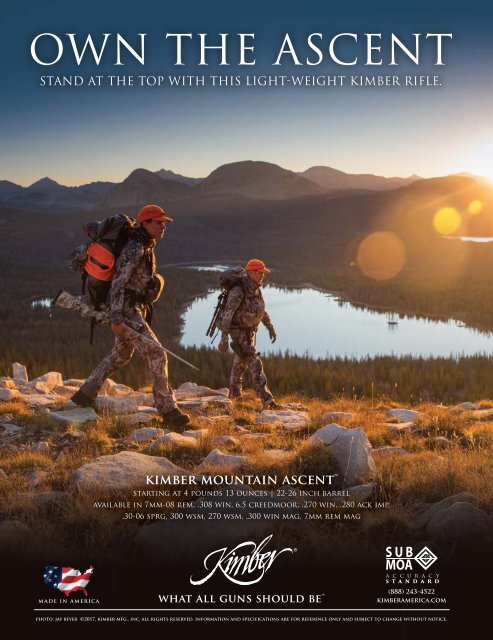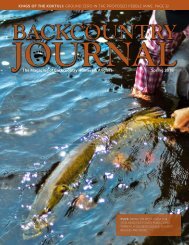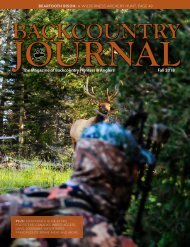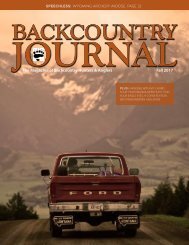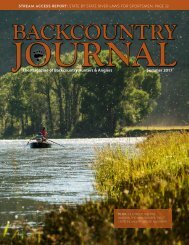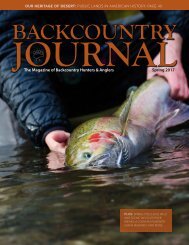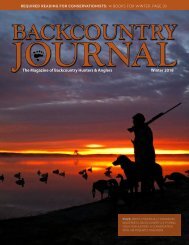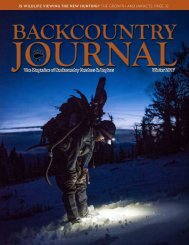BCJ_SUMMER18 Digital Edition
- No tags were found...
Create successful ePaper yourself
Turn your PDF publications into a flip-book with our unique Google optimized e-Paper software.
OWN THE ASCENT<br />
STAND AT THE TOP WITH THIS LIGHT-WEIGHT KIMBER RIFLE.<br />
made in america<br />
18 | BACKCOUNTRY JOURNAL SUMMER 2018<br />
kimber mountain ascent<br />
starting at 4 pounds 13 ounces | 22-26 inch barrel<br />
available in 7mm-08 rem, .308 win, 6.5 creedmoor, .270 win, .280 ack imp,<br />
.30-06 sprg, 300 wsm, 270 wsm, .300 win mag, 7mm rem mag<br />
what all guns should be<br />
SUB<br />
MOA<br />
a c c u r a c y<br />
s t a n d a r d<br />
(888) 243-4522<br />
kimberamerica.com<br />
photo: jay beyer ©2017, kimber mfg., inc. all rights reserved. information and specifications are for reference only and subject to change without notice.<br />
Barry and Cathy Beck photo<br />
BY JAN DIZARD<br />
ON AN OCTOBER MORNING a decade or so ago, I was hunting<br />
woodcock in an abandoned orchard. A flight had come in<br />
and, in less than an hour, I collected my three-bird limit. That<br />
evening I got a call from an acquaintance, a deer hunter, who<br />
hunts the same orchard. He asked how I did and if I’d seen evidence<br />
of deer. How, I asked, had he known I had been hunting<br />
there that morning? He said he saw me on the trail camera he’d<br />
placed in cover. I was amused.<br />
It’s now common to see cameras in the woods I hunt, and it’s<br />
interesting to hear from friends who share the pictures of animals<br />
their cameras record. I’m primarily a bird hunter so field cameras<br />
are of no use, though I have thought it would be neat to position<br />
a camera near a grouse drumming log to get some pictures of<br />
the showoff. It’s clear that a deer hunter can make good use of a<br />
game camera or two. It’s also clear that the technology is a useful<br />
tool for wildlife researchers. More broadly, I know public school<br />
and college teachers who have their students use remote cameras<br />
to record animal activities in their backyards and neighborhoods.<br />
Anything that gets young people outdoors and engaged in appreciating<br />
wildlife is a good thing.<br />
But there is a downside that hunters in particular must face,<br />
and it’s gotten more acute with the development of so-called “live<br />
action game cameras,” units that record and transmit images in<br />
real time to a smart phone or other hand-held device. Does this<br />
technology tilt the playing field too far in favor of the hunter? Are<br />
you really hunting if your phone notifies you when a buck has<br />
stepped into the food plot?<br />
This is not a new problem. Philosophers in ancient Greece worried<br />
about our ability to take unfair advantage over animals. Jose<br />
Ortega y Gassett praised hunters who deliberately handicapped<br />
themselves to make the contest between hunter and hunted a<br />
challenge. Aldo Leopold worried that “gadgets” would corrupt<br />
hunting: Even if the gadgets didn’t improve hunters’ chances of<br />
making a kill, they placed too much emphasis on the kill at the<br />
expense of the challenge of the chase. Theodore Roosevelt was<br />
characteristically blunt on the same subject: “The rich people,<br />
who are content to buy what they have not the skill to get by<br />
their own exertions – these are the men who are the real enemies<br />
of game.”<br />
BEYOND FAIR CHASE<br />
LIVE ACTION<br />
GAME CAMERAS<br />
TR was familiar with both riches and exertion, but today, technology<br />
does not require inherited wealth. We have to ask ourselves<br />
if we want to make hunting easier, and perhaps more importantly,<br />
do we want to make success, defined as a kill, more certain? In any<br />
given year, no more than 20 percent of all deer and elk hunters<br />
harvest their animals. That they keep hunting, year in and year<br />
out, suggests that they are hunting for complex reasons that go far<br />
beyond the desire to kill: Failing to do so in any given year only<br />
heightens the expectations for next year.<br />
Available technology now makes it possible for hunters to reduce<br />
the time they otherwise would have to invest in preseason<br />
scouting, even time afield during the season. Game cameras have<br />
become inexpensive, enabling hunters to check the movement<br />
of game in areas they intend to hunt without investing precious<br />
hours with boots on the ground. It’s easy to see how substituting<br />
technology for the laborious process of acquiring intimate knowledge<br />
of game is tempting, especially given the fact that for most<br />
hunters, there are many claims on “free” time.<br />
At this writing (February 2018) only three states have banned<br />
live action cameras in season (Montana requires that all cameras<br />
be removed during the hunting season.) A few more are considering<br />
regulations. This is an issue that will become more pressing<br />
as cameras get more sophisticated. And then there are camera-equipped<br />
drones that raise even knottier ethical questions.<br />
Sixteen states have banned drones in season, thanks in part to<br />
advocacy by BHA.<br />
We are facing the wicked problem of the “slippery slope”:<br />
Where do we draw the line between the acceptable and the unacceptable?<br />
Is the line purely a personal preference or ought there<br />
to be regulations that say cameras are OK for preseason scouting<br />
but not during the hunting season? Ought we draw a line between<br />
conventional and live-action cameras? And drones?<br />
At bottom, the question is one of fair chase. Do live-action<br />
cameras unacceptably tilt the playing field? There’s room for debate,<br />
but one thing is certain: The price of technology will go<br />
down and the ethical costs associated with accepting increasingly<br />
sophisticated electronic mediation between hunter and hunted<br />
will go up.<br />
Jan is a board member of Orion and BHA life member. A retired<br />
professor, he splits his time between Massachusetts and California.<br />
This department is brought to you by Orion - The Hunter’s Institute,<br />
a nonprofit and BHA partner dedicated to advancing hunting<br />
ethics and wildlife conservation. To discuss this article and others,<br />
go to backcountryhunters.org/fair_chase.<br />
SUMMER 2018 BACKCOUNTRY JOURNAL | 19


